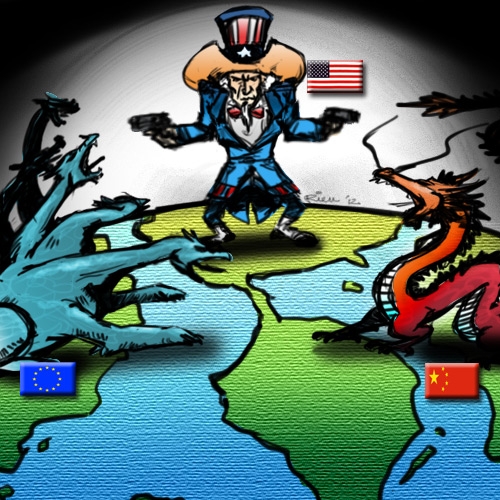[captionpix align=”left” theme=”elegant” width=”320″ imgsrc=”http://natoassociation.ca/wp-content/uploads/2012/12/showdown_-2.jpg” captiontext=”The rise of the triumvirate regional blocs centered in Europe, North America, and East Asia”]
The broadening and deepening of interactions and interdependence among people and states in the 21 century have intensified because of technological advances and trade liberalization. This has created deep interconnection between countries―changing the scope, depth, and speed in which states interact with each other. Linkages between states, societies, and economies appear to be strengthening. Long-standing institutions, assumptions, and norms are being challenged. The web of global connections is becoming increasingly thick. But what is the perceived drive behind this novel economic force? It is called economic globalization. The term “globalization” is nothing new to the general public, and in fact, it can be considered a household term. Whether you are an investor who has reaped the benefits from globalized trade, or an unemployed worker who lost their job because of outsourcing, the term “globalization” is well-known and is either embraced with optimism or met with anxiety and dread.
Human beings are no longer part of isolated communities that are themselves linked through narrow channels of diplomatic relations or trade. Patrick H. O’Neil, a professor of Politics and Government at the University of Puget Sound says, “Entire societies are now directly connected to global affairs.” Indeed, traditional notions of sovereignty are being displaced by dramatic political change, causing sovereignty to decline and states to be “hollowed out,” no longer able to act independently within their own territory, constrained within an international system, with reliance on a world economy. But does this trend of integration reflect globalization or regionalism? The international realm is in an anarchic state and there is no effective form of global governance, so naturally, states will gravitate to the nearest regional power for security, investment, and geopolitical interests. For example, Canada sought free trade with the United States to gain more assured access to the U.S. market. Furthermore, the NAFTA negotiations demonstrated that the United States would opt for regionalism as an alternative to multilateralism.
The intensification of worldwide social relations is part of a global phenomenon, but what is considered to be economic globalization is actually regionalism. Global competitiveness has led to the formation of three economic blocs centered in Europe, North America, and East Asia. Competitiveness has caused states to be concerned with their relative place in the global economy. Instead of a “borderless world,” the formation of powerful regional economic blocs has emerged to safeguard national economies.
Pankaj Ghemawat, a professor at the Harvard Business School is critical of the idea of a “borderless world.” He sees mountains and deep valleys―restrictions and impediments―that obstruct globalization and encourage investments in near regions. For example, seventy percent of Canada’s trade with the United States is intra-industry while 40 percent is within the same company. Canadians became the No. 1 foreign buyers of homes in the United States, accounting for 23.6 percent of all purchases, twice as much as the next country. U.S foreign direct investment in Canada increased almost four times, from $59.1 billion to $227.3 billion and in Mexico, the increase was nearly twenty times―from 5.4 billion to $95.6 billion after NAFTA was implemented. China and its regional partners account for more than half of inbound foreign direct investment and three-quarters of imports. One could go on to cite other makers of regionalization, but experts such as Pankaj Ghemawat generally agree that the world has become increasingly regionalized in recent years because of the declining importance of the United States as a hegemonic superpower.
Alan Rugman, Professor of International Business at Henley Business School, and Chang H. Oh, Associate Professor of International Business at Simon Fraser University, also agree that the concept of globalization masks a trend that is actually regional. They disagree with Thomas Friedman’s “flat earth” theory― that worldwide integration and global strategy is feasible― and instead, provide empirical evidence to demonstrate that the world’s largest multinational enterprises (MNEs) do not operate globally, but sell and produce the vast majority of their output within their home region. For instance, they examined the geographical sales of 348 of the 500 largest MNEs in the world and their findings are: 154 firms are North American with 75 percent of their sales in North America, 127 firms are European with 64 percent of their sales in Europe, and 67 firms are Asia-Pacific with 76 percent of their sales in their region.
The world’s largest firms are regional not global, they produce and sell on home region basis. Keep in mind these regional firms have global reach, but their total sales are firmly rooted in a region. Ironically, when Congress introduced the “buy American provisions” after the financial crisis, American companies subsidiaries in Canada and Mexico were denied the chance to bid on contracts. So the U.S. Chamber of Commerce found its self in an awkward position of complaining to Congress that the “buy American provisions” were harming their ability to compete in the U.S. market.
Myth Busted
There is no evidence that U.S. firms operate globally. Instead, they both produce and sell on a home region basis, as do MNEs from Europe and Asia. As Rugman and Oh point out,
“North America is a battlefield for the world’s corporate giants, but with a strong intra-regional effect. There is a similar picture of triad rivalry between MNEs in Europe and in Asia; again the home MNEs dominate in their home region”
The main vehicles for economic integration are multinational corporations, banks, and small and medium-sized firms. The data presented above confirm the fact that the world’s largest firms are regional, not global. Thus, economic globalization does not exist, it is clearly a mirage.
Policy Recommendations
- For international business, the strategic focus needs to be regional, not global;
- International political economy, which devotes much of its study to the exchange between relatively distinct and national economies, should shift its focus to incorporate a strong regional effect;
- Politically, U.S. and China will use these regional blocs to maintain and increase their hegemonic grasp over the world. Weaker countries such as Canada must remain vigilant and wary of concessions through treaties like NAFTA that promote further integration of their economies, if it does not mutually benefit both countries;
- Measures must be taken now, by policy makers and world leaders to minimize future escalating conflict between the three triumvirate blocs centered in Europe, North America, and East Asia. For example, national governments, international institutions, and non-state actors should continue promoting free trade; trade in the future could be at risk to regional protectionism, and,
- Finally, Economic safe guards such as the World Trade Organization are in need of more formal powers to supervise and liberalize international trade and reduce regional external tariffs.




